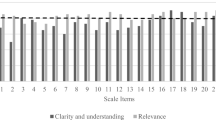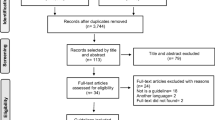Abstract
Introduction and hypothesis
Urinary incontinence affects women of all ages, influencing 8.5% of the world’s population in 2018. Effective management of urinary incontinence is influenced by patients help-seeking behaviour and services offered by healthcare professionals within the healthcare system. To facilitate behavioural change, it is important to understand the knowledge(Knowledge: “the comprehension and understanding of acquired facts or information about UI in adults”), attitudes (Attitude: “a predisposed perspective which influences nurses’ thoughts, feelings, perceptions and behaviours towards care of adults with UI”) and beliefs (Beliefs: “a theoretically conceptualized conviction or expectation regarding UI in general”) of healthcare practitioners towards urinary incontinence management. The aim of this review is thus to systematically map the existing literature, reporting on how knowledge, attitude, belief and practices towards urinary incontinence management have been explored.
Methods
Six databases were systematically searched. Included studies were published between January 2013 to January 2020 in English, investigating urinary incontinence management in women.
Results
The search yielded 39 studies, with data emanating from 16 counties. Quantitative, Qualitative and mixed methodologies were used to explore the four concepts of knowledge, attitudes, beliefs and practices. A wide range of healthcare practitioners were questioned and management was explored in five healthcare settings. All factors explored related to the four concepts are reported and factors reaching consensus in included literature were highlighted.
Conclusion
The summarized factors can assist further investigations into the four concepts to change healthcare practitioner’s behaviour towards urinary incontinence management.


Similar content being viewed by others
Notes
Practice: “actions identified in the AHCPR guideline (Urinary Incontinence Panel, 1992; Fantl et al., 1996) as being within the capability and scope of registered nurses of all educational levels” [53].
Knowledge: “the comprehension and understanding of acquired facts or information about UI in adults” [53].
Attitude: “a predisposed perspective which influences nurses’ thoughts, feelings, perceptions, and behaviours towards care of adults with UI” [53].
Beliefs: “a theoretically conceptualized conviction or expectation regarding UI in general” [53].
Abbreviations
- GP:
-
General practitioner
- HCP:
-
Healthcare practitioners
- HRQOL:
-
Health-related quality of life
- MUI:
-
Mixed urinary incontinence
- NICE:
-
National Institute for Health and Care Excellence
- PFD:
-
Pelvic floor dysfunction
- SUI:
-
Stress urinary incontinence
- UI:
-
Urinary incontinence
- UUI:
-
Urge urinary incontinence
References
Irwin DE, Kopp ZS, Agatep B, et al. Worldwide prevalence estimates of lower urinary tract symptoms, overactive bladder, urinary incontinence and bladder outlet obstruction. BJU Int. 2011;108:1132–9. https://doi.org/10.1111/j.1464-410X.2010.09993.
Milsom I, Coyne KS, Nicholson S, et al. Global prevalence and economic burden of urgency urinary incontinence: a systematic review. Eur Urol. 2014;65:79–95. https://doi.org/10.1016/j.eururo.2013.08.031.
Norton NJ (2007) Impact of fecal and urinary incontinence on health consumers—barriers on diagnosis and treatment—a patient perspective. https://aboutincontinence.org/living-with-incontinence/barriers-on-diagnosis-and-treatment.html. Accessed 20 July 2020.
Krhut J, Gartner M, Mokris J, et al. Effect of severity of urinary incontinence on quality of life in women. Neurol Urodyn. 2018;37:1925–30.
Colborne M, Dahlke S. Nurses’ perceptions and management of urinary incontinence in hospitalized older adults: an integrative review. J Gerontol Nurs. 2017;43:46–55. https://doi.org/10.3928/00989134-20170515-02.
Park S, De GJC, So A, Palmer MH. Knowledge, attitudes, beliefs, and practices in registered nurses and care aids about urinary incontinence in Korean nursing homes a cross-sectional survey. J Wound Ostomy Continence Nurs. 2015;42:183–9. https://doi.org/10.1097/WON.0000000000000095.
Tricco AC, Lillie E, Zarin W, et al. PRISMA extension for scoping reviews (PRISMA-ScR): checklist and explanation. Ann Intern Med. 2018;169:467–73. https://doi.org/10.7326/M18-0850.
Peters MD, Godfrey CM, McInerney P, Soares CB, Khalil H, Parker D (2015) The Joanna Briggs Institute Reviewers’ Manual 2015: Methodology for JBI scoping reviews. Joanne Briggs Institute, p. 1–24. https://doi.org/10.1017/CBO9781107415324.004.
National Institute for Health and Care Excellence (2013) Urinary incontinence in women: the management of urinary incontinence in women. https://www.ncbi.nlm.nih.gov/books/NBK247723/pdf/Bookshelf_NBK247723.pdf. Accessed 1 July 2019.
Bravo-Balado A, Plata M, Trujillo CG, et al. Is the development of clinical practice guidelines for non-neurogenic overactive bladder trustworthy? A critical appraisal using the appraisal of guidelines, research and evaluation (AGREE) II instrument. BJU Int. 2019;93:921–2. https://doi.org/10.1111/bju.14684.
Wijaya RR, Tiffany A, Aulia N, Galisia RP, Rizkita DN, Priyatini T. The association between urinary incontinence knowledge level and its related factors among health workers in Duren Sawit Primary Health Care, East Jakarta, 2016. Adv Sci Lett. 2018;24(9):6900–2. https://doi.org/10.1166/asl.2018.12878.
Burton CS, O’Brien R, Eilber K, Lenore Ackerman A, Anger J. Identifying barriers to urinary incontinence care among primary care providers. Neurourol Urodyn. 2019;38:S94–5. https://doi.org/10.1002/nau.23949.
Ghoniem G, Hammett J. Female pelvic medicine and reconstructive surgery practice patterns: IUGA member survey. Int Urogynecol J. 2015;26:1489–94. https://doi.org/10.1007/s00192-015-2734-5.
Kammerer-Doak D, Svabik K, Bazi T. Variability in practice patterns in stress urinary incontinence and pelvic organ prolapse: results of an IUGA survey. Int Urogynecol J. 2017;28:735–44. https://doi.org/10.1007/s00192-016-3174-6.
Cooke CM, O’Sullivan OE, O’Reilly BA. Urogynaecology providers’ attitudes towards postnatal pelvic floor dysfunction. Int Urogynecol J. 2018;29:751–66. https://doi.org/10.1007/s00192-017-3419-z.
Nguyen K, Hunter KF, Wagg A. Knowledge and understanding of urinary incontinence: survey of family practitioners in northern Alberta. Can Fam Physician. 2013;59:e330–7.
Hutchings J, Sutherland L. Student nurse understanding of the psychosocial impact of urinary incontinence. Urol Nurs. 2014;34:318–25. https://doi.org/10.7257/1053-816x.2014.34.6.318.
Dessie SG, Hacker MR, Dodge LE, Elkadry EA. Do obstetrical providers counsel women about postpartum pelvic floor dysfunction? J Reprod Med. 2015;60:205–10.
Anger JT, Alas A, Litwin MS, et al. The quality of care provided to women with urinary incontinence in two clinical settings. J Urol. 2016;196:1196–200. https://doi.org/10.1016/j.juro.2016.05.005.The.
Mazloomdoost D, Westermann LB, Crisp CC, et al. Primary care providers’ attitudes, knowledge, and practice patterns regarding pelvic floor disorders. Int Urogynecol J. 2017;28:447–53. https://doi.org/10.1007/s00192-016-3134-1.
Mazloomdoost D, Crisp CC, Kleeman SD, Pauls RN. Primary care providers’ experience, management, and referral patterns regarding pelvic floor disorders: a national survey. Int Urogynecol J. 2018;29:109–18. https://doi.org/10.1007/s00192-017-3374-8.
Brown HW, Guan W, Schmuhl NB, et al. If we don’t ask, they won’t tell: screening for urinary and fecal incontinence by primary care providers. J Am Board Fam Med. 2018;31:774–82. https://doi.org/10.3122/jabfm.2018.05.180045.
Moskowitz D, Adelstein SA, Lucioni A, et al. Use of third line therapy for overactive bladder in a practice with multiple subspecialty providers—are we doing enough? J Urol. 2018;199:779–84. https://doi.org/10.1016/j.juro.2017.09.102.
Geynisman-Tan J, Brown O, Mueller M, et al. Changing referral patterns to urogynecology. Female Pelvic Med Reconstr Surg. 2018;24:48–50. https://doi.org/10.1097/SPV.0000000000000416.
Wong JW, Kaneshiro BE, Oyama IA. Primary care physician perceptions of female pelvic floor disorders. Hawaii J Med Public Health. 2019;78:132–6.
Jang Y, Kwon BE, Kim HS, et al. Knowledge and practice behaviors regarding urinary incontinence among Korean healthcare providers in long-term care hospitals. Int Neurourol J. 2015;19:259–64. https://doi.org/10.5213/inj.2015.19.4.259.
Sarit-Apirak S, Udomsubpayakul U, Manonai J. Knowledge and practice of nurses and practical nurses in tertiary health care center regarding pelvic organ prolapse and urinary incontinence. Int Urogynecol J Pelvic Floor Dysfunct. 2016;27:86–92.
Luo Y, Parry M, Huang YJ, et al. Nursing students’ knowledge and attitudes toward urinary incontinence: a cross-sectional survey. Nurse Educ Today. 2016;40:134–9. https://doi.org/10.1016/j.nedt.2016.02.020.
Sinha S, Yande S, Patel A, et al. The urological Society of India survey on urinary incontinence practice patterns among urologists. Indian J Urol. 2018;34:202–10. https://doi.org/10.4103/iju.IJU_85_18.
De Almeida Tavares JP, da Silva AL, Sa-Couto P, et al. Portuguese nurses’ knowledge of and attitudes toward hospitalized older adults. Scand J Caring Sci. 2015;29(1):51–61. https://doi.org/10.1111/scs.12124.
Coşkun B, Bayrak Ö, Dinçer M, et al. The attitudes of urologists and gynecologists about overactive bladder and treatment of it in Turkey: a questionnaire survey. Turkish J Urol. 2017;43:68–74. https://doi.org/10.5152/tud.2016.93467.
Yenişehir S, Karakaya İÇ, Karakaya MG. Knowledge and practice of nursing home caregivers about urinary incontinence. Eur Geriatr Med Soc. 2019;10:99–105. https://doi.org/10.1007/s41999-018-0129-0.
Caliskan N, Gulnar E, Aydogan S, et al. Obstacles to providing urinary incontinence care among nurses in Turkey: a descriptive study. Wound Manag Prev. 2019;65:36–47. https://doi.org/10.25270/wmp.2019.9.3647.
Mandl M, Halfens RJG, Lohrmann C. Incontinence care in nursing homes: a cross-sectional study. J Adv Nurs. 2015;71:2142–52. https://doi.org/10.1111/jan.12676.
Witkoś J, Hartman-Petrycka M. Will future doctors know enough about stress urinary incontinence to provide proper preventive measures and treatment? Med Educ Online. 2019;24:1685635. https://doi.org/10.1080/10872981.2019.1685635.
Ostaszkiewicz J, O’Connell B, Dunning T. Night-time continence care in Australian residential aged care facilities: findings from a grounded theory study. Contemp Nurse. 2016;52:152–62. https://doi.org/10.1080/10376178.2015.1011047.
Ostaszkiewicz J, O’Connell B, Dunning T. “We just do the dirty work”: dealing with incontinence, courtesy stigma and the low occupational status of carework in long-term aged care facilities. J Clin Nurs. 2016;25:2528–41. https://doi.org/10.1111/jocn.13292.
Ostaszkiewicz J, O’Connell B, Dunning T. Fear and overprotection in Australian residential aged-care facilities: the inadvertent impact of regulation on quality continence care. Australas J Ageing. 2016;35:119–26. https://doi.org/10.1111/ajag.12218.
Ostaszkiewicz J, Tomlinson E, Hutchinson AM. “Dignity”: a central construct in nursing home staff understandings of quality continence care. J Clin Nurs. 2018;27:2425–37. https://doi.org/10.1111/jocn.14293.
Hälleberg Nyman M, Forsman H, Ostaszkiewicz J, et al. Urinary incontinence and its management in patients aged 65 and older in orthopaedic care—what nursing and rehabilitation staff know and do. J Clin Nurs. 2016;26:3345–53. https://doi.org/10.1111/jocn.13686.
Jonasson LL, Josefsson K. Staff experiences of the management of older adults with urinary incontinence. Heal Aging Res. 2016;05:1–11. https://doi.org/10.12715/har.2016.5.13.
Borglin G, Hew Thach E, Jeppsson M, Sjögren Forss K. Registered nurse’s experiences of continence care for older people: a qualitative descriptive study. Int J Older People Nursing. 2019;00:e12275. https://doi.org/10.1111/opn.12275.
Wagg AR, Kendall S, Bunn F. Women’s experiences, beliefs and knowledge of urinary symptoms in the postpartum period and the perceptions of health professionals: a grounded theory study. Prim Health Care Res Dev. 2017;18:448–62. https://doi.org/10.1017/S1463423617000366.
Hahn SR, Bradt P, Hewett KA, Ng DB. Physician-patient communication about overactive bladder: results of an observational sociolinguistic study. PLoS One. 2017;12:e0186122. https://doi.org/10.1371/journal.pone.0186122.
Tomasi AVR, dos SSMA, Honório GJ da S, Locks MOH. Urinary incontinence in elderly people: care practices and care proposal in primary health care. Texto Context - Enferm. 2017;e6800015:26. https://doi.org/10.1590/0104-07072017006800015.
Yu P, Traynor V, Hailey D. Urinary continence care in Australian nursing homes. Aust J Adv Nurs. 2014;32:39–46.
Barakat-Johnson M, Barnett C, Lai M, et al. Incontinence, incontinence-associated dermatitis, and pressure injuries in a health district in Australia: a mixed-methods study. J Wound Ostomy Continence Nurs. 2018;45:349–55. https://doi.org/10.1097/WON.0000000000000446.
Jirscehele K, Ross R, Goldberg R, Botros S. Physician attitudes toward urinary incontinence identification. Female Pelvic Med Reconstr Surg. 2015;21:273–6. https://doi.org/10.1097/SPV.0000000000000165.
Artero-López C, Márquez-Hernández VV, Estevez-Morales MT, Granados-Gámez G. Inertia in nursing care of hospitalised patients with urinary incontinence. J Clin Nurs. 2018;27:1488–96. https://doi.org/10.1111/jocn.14289.
Ferdinand S. Continence care education: views of students and registered nurses. Br J Nurs. 2018;27:852–9. https://doi.org/10.12968/bjon.2018.27.15.852.
Kalpokaite N. Deductive vs. inductive reasoning in research. In: ATLAS.ti. https://intercom.help/atlasti_cloud/en/articles/1921546-deductive-vs-inductive-reasoning-in-research. Accessed 26 October 2020.
Jacobs LC, Hanekom SD, van Rensburg K. Help-seeking behaviour of women with urinary incontinence. Stellenbosch: Stellenbosch University; 2017.
Henderson JS, Kashka MS. Development and testing of the urinary incontinence scales. Urol Nurs. 1999;19:109–19.
Funding
This scoping review was self-funded by the primary investigator.
Author information
Authors and Affiliations
Contributions
Anika Janse van Vuuren: project development, data collection, data analysis, manuscript writing and editing; Susan Hanekom: project development, manuscript editing; J.A. van Rensburg and Lonese Jacobs: project development.
Corresponding author
Ethics declarations
Financial disclaimer
None
Conflicts of interest
None
Additional information
Publisher’s note
Springer Nature remains neutral with regard to jurisdictional claims in published maps and institutional affiliations.
Appendix
Appendix
Web of Science search:
Search limits:
Time: January 2013 to January 2020
Language: English
The same process was repeated in each database. Thereafter, applicable study duplicates between databases were removed.
Rights and permissions
About this article
Cite this article
van Vuuren, A.J., van Rensburg, J.A., Jacobs, L. et al. Exploring literature on knowledge, attitudes, beliefs and practices towards urinary incontinence management: a scoping review. Int Urogynecol J 32, 485–499 (2021). https://doi.org/10.1007/s00192-020-04628-3
Received:
Accepted:
Published:
Issue Date:
DOI: https://doi.org/10.1007/s00192-020-04628-3






